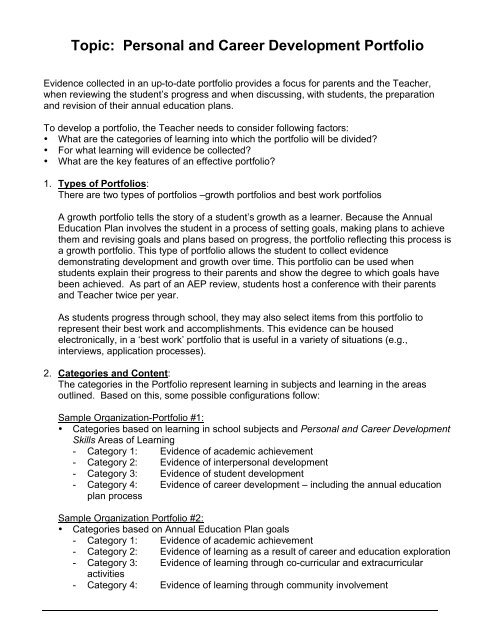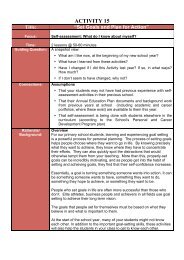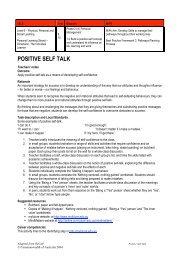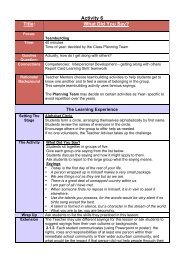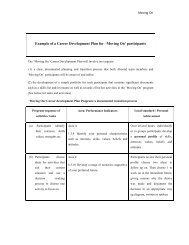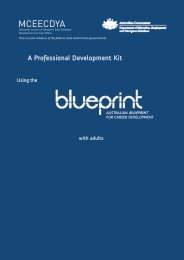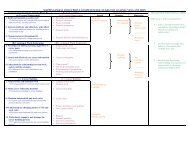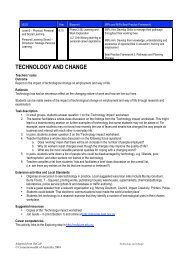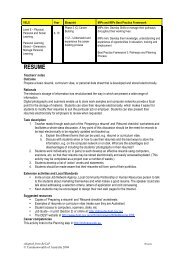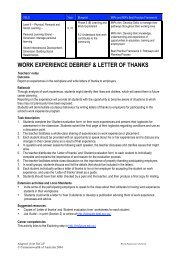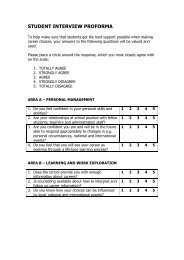Topic: Personal and Career Development Portfolio - Blueprint ...
Topic: Personal and Career Development Portfolio - Blueprint ...
Topic: Personal and Career Development Portfolio - Blueprint ...
Create successful ePaper yourself
Turn your PDF publications into a flip-book with our unique Google optimized e-Paper software.
<strong>Topic</strong>: <strong>Personal</strong> <strong>and</strong> <strong>Career</strong> <strong>Development</strong> <strong>Portfolio</strong><br />
Evidence collected in an up-to-date portfolio provides a focus for parents <strong>and</strong> the Teacher,<br />
when reviewing the student’s progress <strong>and</strong> when discussing, with students, the preparation<br />
<strong>and</strong> revision of their annual education plans.<br />
To develop a portfolio, the Teacher needs to consider following factors:<br />
• What are the categories of learning into which the portfolio will be divided?<br />
• For what learning will evidence be collected?<br />
• What are the key features of an effective portfolio?<br />
1. Types of <strong>Portfolio</strong>s:<br />
There are two types of portfolios –growth portfolios <strong>and</strong> best work portfolios<br />
A growth portfolio tells the story of a student’s growth as a learner. Because the Annual<br />
Education Plan involves the student in a process of setting goals, making plans to achieve<br />
them <strong>and</strong> revising goals <strong>and</strong> plans based on progress, the portfolio reflecting this process is<br />
a growth portfolio. This type of portfolio allows the student to collect evidence<br />
demonstrating development <strong>and</strong> growth over time. This portfolio can be used when<br />
students explain their progress to their parents <strong>and</strong> show the degree to which goals have<br />
been achieved. As part of an AEP review, students host a conference with their parents<br />
<strong>and</strong> Teacher twice per year.<br />
As students progress through school, they may also select items from this portfolio to<br />
represent their best work <strong>and</strong> accomplishments. This evidence can be housed<br />
electronically, in a ‘best work’ portfolio that is useful in a variety of situations (e.g.,<br />
interviews, application processes).<br />
2. Categories <strong>and</strong> Content:<br />
The categories in the <strong>Portfolio</strong> represent learning in subjects <strong>and</strong> learning in the areas<br />
outlined. Based on this, some possible configurations follow:<br />
Sample Organization-<strong>Portfolio</strong> #1:<br />
• Categories based on learning in school subjects <strong>and</strong> <strong>Personal</strong> <strong>and</strong> <strong>Career</strong> <strong>Development</strong><br />
Skills Areas of Learning<br />
- Category 1: Evidence of academic achievement<br />
- Category 2: Evidence of interpersonal development<br />
- Category 3: Evidence of student development<br />
- Category 4: Evidence of career development – including the annual education<br />
plan process<br />
Sample Organization <strong>Portfolio</strong> #2:<br />
• Categories based on Annual Education Plan goals<br />
- Category 1: Evidence of academic achievement<br />
- Category 2: Evidence of learning as a result of career <strong>and</strong> education exploration<br />
- Category 3: Evidence of learning through co-curricular <strong>and</strong> extracurricular<br />
activities<br />
- Category 4: Evidence of learning through community involvement
In this resource, sample activities are explicitly linked to the <strong>Personal</strong> <strong>and</strong> <strong>Career</strong> <strong>Development</strong><br />
Skills competencies described in the three areas of learning.<br />
3. Key Features of an Effective <strong>Portfolio</strong>:<br />
a) Use of the portfolio process:<br />
The students collect evidence according to the categories in the portfolio. The students<br />
reflect on key pieces of evidence by:<br />
- identifying the learning associated with the evidence<br />
- assessing how well they apply their learning<br />
- determining next steps<br />
b) Completion:<br />
Evidence is included for education plan goals.<br />
c) Multiple Samples:<br />
The students collect several samples of evidence to show growth over time.
Academic <strong>and</strong> <strong>Career</strong> <strong>Portfolio</strong><br />
SAMPLE ACTIVITIES - Overview<br />
Academic <strong>and</strong> <strong>Career</strong> <strong>Portfolio</strong><br />
Year 3/4 Year 5 Year 6 Year 7<br />
1.<br />
Students ...<br />
Collecting for My<br />
<strong>Portfolio</strong><br />
Collecting for My<br />
<strong>Portfolio</strong><br />
Collecting for My<br />
<strong>Portfolio</strong><br />
Collecting for My<br />
<strong>Portfolio</strong><br />
2.<br />
Students ...<br />
• Review the<br />
existing Primary<br />
School portfolio<br />
collection<br />
process in your<br />
school.<br />
• discuss any<br />
possible<br />
additional<br />
portfolio<br />
contents<br />
Selecting from My<br />
<strong>Portfolio</strong><br />
• review the<br />
portfolio<br />
collection process<br />
• discuss portfolio<br />
contents<br />
Selecting from My<br />
<strong>Portfolio</strong><br />
• check portfolio<br />
contents<br />
• determine<br />
additional contents<br />
for Year 6<br />
Selecting from My<br />
<strong>Portfolio</strong><br />
• check portfolio<br />
contents<br />
• determine<br />
additional contents<br />
for Year 7<br />
Selecting from My<br />
<strong>Portfolio</strong><br />
• review purpose<br />
for selecting<br />
portfolio items<br />
• select portfolio<br />
items for the<br />
review/revision<br />
process of the<br />
student’s Annual<br />
Education Plan<br />
(AEP)<br />
• review purpose<br />
for selecting<br />
portfolio items<br />
• select portfolio<br />
items for the<br />
review/revision<br />
process of the<br />
AEP<br />
• select portfolio<br />
items for the<br />
review/revision<br />
process of the<br />
AEP<br />
• select portfolio<br />
items for a specific<br />
‘transition to high<br />
school’ purpose<br />
(e.g., completing a<br />
personal<br />
information form for<br />
secondary<br />
admission)
Focus:<br />
Title<br />
Guiding<br />
Questions:<br />
Connections:<br />
Time:<br />
Background:<br />
Academic <strong>and</strong> <strong>Career</strong> <strong>Portfolio</strong><br />
How do I know what to collect?<br />
How do I reflect?<br />
Activity 16<br />
Collecting for My <strong>Portfolio</strong><br />
Competencies: Student <strong>Development</strong> – lifelong learning<br />
Report Card Learning Skill: Teamwork<br />
50+ minutes– may require two meetings, depending on students’ prior<br />
knowledge<br />
February<br />
As explained in the introduction to this topic , the Teacher/Mentor is well<br />
suited to assisting students in their Teacher/ Mentor groups in the<br />
development of their Academic <strong>and</strong> <strong>Career</strong> <strong>Portfolio</strong>s. This lesson helps<br />
students, whether they have portfolios or not, to apply the concept of<br />
collecting <strong>and</strong> reflecting on evidence of their learning in school.<br />
Throughout the year, the Teacher/Mentor structures Teacher/ Mentor<br />
meetings so that students have opportunities to gather evidence of their<br />
learning in school, place this evidence in the categories of their electronic<br />
portfolio on SCHOOL Online or their hard-copy Journal, <strong>and</strong> reflect on<br />
their learning as represented by some of the key pieces of evidence.<br />
All students are seeking evidence of their learning in subjects <strong>and</strong> in the<br />
learning areas outlined in Teacher / Mentor Program (TMP). When<br />
students collect evidence, the focus of this collection is determined by the<br />
organization of their portfolios (i.e., according to the College’s graduation<br />
expectations OR according to AEP goals OR according to learning in<br />
subjects, interpersonal development, student development <strong>and</strong> career<br />
development/AEP process)<br />
Students keep their evidence of learning in an electronic portfolio format<br />
on SCHOOL Online.
Setting The<br />
Stage<br />
The Learning Experience<br />
Initiate a discussion about summer holidays, seeing new places <strong>and</strong> doing new<br />
things. Ask students to share something they learned to do over the summer<br />
(babysitting, swimming, surfing, sailing, skills involved in a summer job, helping<br />
around the house).<br />
Ask students to select a partner <strong>and</strong> discuss:<br />
What knowledge <strong>and</strong> skills did I use?<br />
(how to body-surf <strong>and</strong> board-surf, turn <strong>and</strong> stop on the wave, how to stay calm <strong>and</strong><br />
concentrate)<br />
How well did I use these knowledge <strong>and</strong> skills?<br />
(e.g., did not do as well board surfing, turning)<br />
What are my next steps?<br />
(e.g., continue surfing next summer, practice turning <strong>and</strong> stopping on a wave)<br />
In what other situation might I use these skills/this knowledge?<br />
(e.g., some skills apply to surfing, the thinking skills (concentration in a pressure<br />
situation) can apply to interviews, exam writing, school sports, emergency<br />
situations)<br />
The Teacher Mentor uses the term “transferable skills” when applying skills in<br />
different situations. Ask students to share some examples transferable skills with<br />
the group.<br />
The Activity<br />
Ask how they might provide evidence of proof of skills or knowledge they applied<br />
in these situations (e.g., a photograph, a video, a best player award).<br />
<strong>Portfolio</strong> <strong>Development</strong> Process<br />
Although some students, particularly Year 7 School members, may have learned<br />
the portfolio development process, this is new information for most others. The<br />
Year 7 students could act as mentors with the younger children.<br />
Remind students that, in the Teacher Mentor program, they practice skills they can<br />
use in other classes <strong>and</strong> in other life situations now <strong>and</strong> in the future. Distribute<br />
Activity Sheet 4A <strong>Portfolio</strong> Contents – Skills Reflection <strong>and</strong> review the<br />
desirability, application <strong>and</strong> importance of the areas of expertise <strong>and</strong> the abilities<br />
outlined in the skills inventory.<br />
Use this list to describe your own abilities when considering evidence for your<br />
portfolio.<br />
Refer to the example “teamwork” on the Activity sheet, discuss the steps in the<br />
portfolio process related to learning to function as an effective team member <strong>and</strong><br />
clarify what “evidence” of teamwork might look like.<br />
Distribute Activity Sheet 4B <strong>Portfolio</strong> <strong>Development</strong> Process.<br />
Refer to the example “teamwork” on the Activity sheet <strong>and</strong> discuss how the<br />
process works.
• Identify learning<br />
• Apply learning<br />
• Collect evidence of learning<br />
• Reflect on learning<br />
• Decide on next steps<br />
This process helps students think of the types of evidence of knowledge <strong>and</strong> skills<br />
they can gather. It is also an opportunity for goal setting in areas that need<br />
improvement.<br />
What else do I collect?<br />
Let students know that the portfolio icon on some of their Activity sheets means<br />
they should keep those sheets in their portfolios/folders.<br />
There are other items students may suggest as important collection items. For<br />
example: they should think about their subjects <strong>and</strong> what they do well in; projects;<br />
artwork; journals; volunteer experiences; work experiences; hobbies; co-curricular<br />
<strong>and</strong> extracurricular involvement; awards or any form of recognition; etc.<br />
H<strong>and</strong> out Activity Sheets 4C (Years 8 - 10 <strong>Portfolio</strong> Contents), Activity Sheets<br />
4D (Year 11 <strong>Portfolio</strong> Contents) <strong>and</strong> Activity Sheets 4E (Year 12 <strong>Portfolio</strong><br />
Contents) as a checklist. Encourage students to add to the list.<br />
Evidence of applying Multiple Intelligences<br />
If students are aware of their dominant intelligences, ask them to use them during<br />
the next week as they take notes in class or as they study <strong>and</strong> do their homework.<br />
(e.g., a student with a dominant visual-spatial intelligence draws diagrams <strong>and</strong><br />
charts to remember ideas or to record key ideas heard in class).<br />
If students are not aware of the dominant intelligences they may complete the<br />
questionnaire in Appendix 4 or refer to this website<br />
www.edu.gov.on.ca/eng/gen/elemsec/job/prospect/eng/3b.html<br />
Students collect at least 2 pieces of evidence of their use of one of their dominant<br />
intelligences during the week. They bring them to the next Teacher Mentor<br />
meeting.<br />
At the next Teacher Mentor meeting, students select the best example of applying<br />
one of their dominant intelligences, reflect on this evidence using the questions<br />
below, attach these reflections to the evidence <strong>and</strong> store the evidence in their<br />
portfolios.<br />
• What skills or knowledge did I use?<br />
• How well did I use these skills or this knowledge?<br />
• What are my next steps?
Wrap Up<br />
Summarize the portfolio collection process.<br />
In future Teacher Mentor meetings, students use their AEP goals as a focus for<br />
portfolio development <strong>and</strong> other focus areas as determined by the school’s<br />
Teacher Mentor Planning Team.<br />
Students:<br />
• collect samples of work as evidence of strategies, skills or knowledge they<br />
apply to achieve the goals<br />
• reflect on their progress<br />
• plan next steps<br />
Extension<br />
1.1.2 Students who are unfamiliar with the portfolio development process may<br />
need to explore additional information on the purpose <strong>and</strong> benefits of a portfolio.<br />
4.1.2 <strong>Career</strong> Awareness Days – Presenters reflect on own Life long learning<br />
roles, within their work <strong>and</strong> in the rest of their lives e.g Leader <strong>and</strong> Collaborator<br />
role was colourfully explained by a mother of five, also a lawyer, who gave<br />
examples of being a Leader <strong>and</strong> Collaborator in both her personal life <strong>and</strong> her<br />
professional life.<br />
8.1.13 Students given many opportunities to make decisions, both individually<br />
<strong>and</strong> as groups.<br />
11.1.10 Middle school students can be given the opportunity to select special<br />
interests that they want to pursue: Year 6 students can choose the group they<br />
want to work with to organise the <strong>Career</strong> Awareness Day (e.g creating or<br />
performing in the opening ceremony), <strong>and</strong> Year 7 can choose their Leadership<br />
Group<br />
Materials:<br />
Teacher Program Review – Reflective Question<br />
What lifelong learning skills are students acquiring?<br />
Activity Materials<br />
Activity Sheet 4A <strong>Portfolio</strong> Contents – Skills Reflection<br />
Activity Sheet 4B <strong>Portfolio</strong> <strong>Development</strong> Process<br />
Students’ portfolios/journals/folders<br />
<strong>Blueprint</strong> <strong>Career</strong> Management Competencies & Indicators<br />
1.1.2 Discover how positive characteristics are the basis of a positive self concept.<br />
4.1.2 Discover how different kinds of work require different combinations of skill <strong>and</strong> knowledge<br />
8.1.13 Engage in responsible decision-making..<br />
11.1.10 Plan <strong>and</strong> take part in an activity of interest <strong>and</strong> describe what has been learned during the<br />
activity<br />
Teacher’s<br />
Notes:
Journal 4A<br />
<strong>Portfolio</strong> Contents – Skills Reflection<br />
The following skills inventory lists areas of expertise <strong>and</strong> abilities.<br />
Use this list to describe your own abilities when considering evidence for your portfolio.<br />
Communication: • speaking clearly <strong>and</strong> concisely<br />
• writing effectively<br />
• reading quickly with underst<strong>and</strong>ing<br />
• listening objectively<br />
• talking confidently in public<br />
Leadership: • making decisions<br />
• supervising<br />
• initiating<br />
• planning<br />
• organizing<br />
• coaching<br />
• compromising <strong>and</strong> following instructions<br />
• working independently<br />
Organization Skills: • managing information<br />
• scheduling<br />
• coordinating<br />
• classifying<br />
• taking responsibility for task, group or self<br />
Being Creative <strong>and</strong><br />
Imaginative:<br />
• inventing<br />
• improvising<br />
• experimenting/adapting<br />
• performing<br />
• drawing <strong>and</strong> writing<br />
• accepting change as a challenge<br />
• taking risks<br />
Problem Solving: • defining the problem<br />
• showing imagination <strong>and</strong> creativity<br />
• distinguishing between fact <strong>and</strong> fiction<br />
• summarizing <strong>and</strong> evaluating solutions<br />
Team Work Skills: • discussing<br />
• working with people<br />
• facilitating<br />
• cooperating<br />
• maintaining a positive outlook<br />
Technical Skills: • using computers<br />
• operating/maintaining equipment<br />
• measuring/enumerating<br />
• accessing information from many sources<br />
Interpersonal Skills • maintaining a positive attitude<br />
• underst<strong>and</strong>ing the failings of others<br />
• encouraging <strong>and</strong> motivating others<br />
• resolving conflict<br />
• appreciating others’ efforts
Journal 4B<br />
<strong>Portfolio</strong> <strong>Development</strong> Process<br />
Student’s Name: ____________________________ Date:__________________________________<br />
THE PORTFOLIO DEVELOPMENT PROCESS<br />
1.<br />
Identify<br />
Learning<br />
5.<br />
Decide on<br />
Next Steps<br />
2.<br />
Apply<br />
Learning<br />
4.<br />
Reflect on<br />
Learning<br />
dge)<br />
3.<br />
Collect<br />
Evidence of<br />
Learning<br />
1. Identify Learning<br />
What knowledge <strong>and</strong> skills did I learn?<br />
(e.g., teamwork)<br />
What would it look like if I applied it well?<br />
(e.g., participating, listening, asking questions, doing my share of the work)<br />
2. Apply Learning<br />
In what other situation might I use these skills/this knowledge?<br />
(e.g., in my science lab group work)<br />
3. Collect Evidence of Learning<br />
What evidence of proof of the skills or knowledge do I have?<br />
(e.g., copy of my self-assessment, feedback from my teacher)<br />
4. Reflect on Learning<br />
How well did I use this knowledge/skill?<br />
(e.g., I did well in other areas but I need to pay more attention to my listening skills in a<br />
group situation)<br />
What evidence do I have to show?<br />
(e.g., peer evaluation sheet)<br />
5. Decide on Next Steps<br />
What are my next steps?<br />
(e.g., I will set a goal to practice my listening skills in all of my classes)


